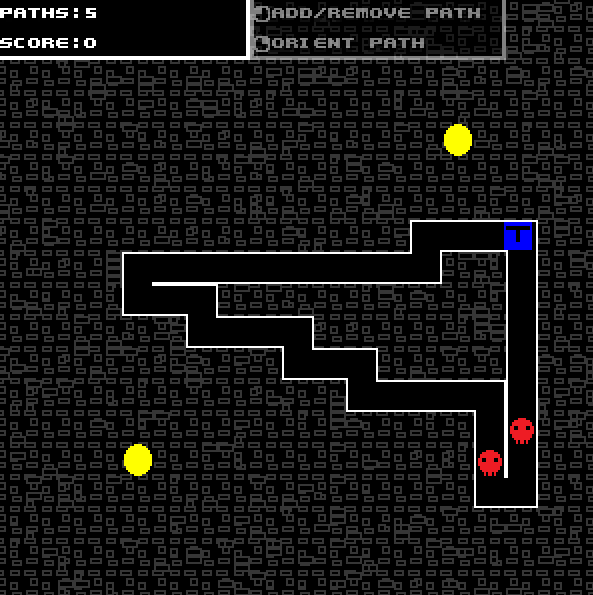ARAVIND SUNDARARAJAN
EZD - Experimental Track-Based Game
An experimental track-based puzzle game developed for an early Ludum Dare game jam using GameMaker Studio
Project Overview
EZD (EZDungeon) is an experimental track-based puzzle game that explores unique gameplay mechanics through a combination of track building, enemy avoidance, and strategic movement. The game challenges players to navigate through increasingly complex levels while collecting coins and avoiding enemies.
Developed as a submission to a very early Ludum Dare game jam, this project represents one of the earliest experiments in game development, showcasing fundamental programming concepts and creative problem-solving under time constraints. The game demonstrates the ability to create engaging gameplay using simple mechanics and clear visual design.
The track-based system creates a unique puzzle element where players must think strategically about movement patterns and enemy behavior. The game combines elements of puzzle-solving with action gameplay, creating an accessible yet challenging experience that showcases early game development skills.
Interactive Gameplay

Gameplay Features
- Track-Based Movement - Navigate through interconnected track systems
- Enemy Avoidance - Strategic movement to avoid pursuing enemies
- Coin Collection - Gather coins while navigating the tracks
- Puzzle Elements - Solve track-based puzzles and challenges
- Progressive Difficulty - Increasingly complex level design
Core Mechanics
- Track Navigation - Move along horizontal, vertical, and corner track pieces
- Enemy AI - Enemies follow predictable patterns requiring strategic thinking
- Resource Management - Balance coin collection with survival
- Level Progression - Advance through multiple rooms with increasing complexity
- Real-Time Strategy - Make quick decisions under pressure
Key Features
Gameplay Systems
- Track-based movement system
- Enemy AI and pathfinding
- Coin collection mechanics
- Level progression system
- Puzzle-solving elements
Technical Implementation
- GameMaker Studio development
- HTML5 web deployment
- Sprite-based graphics
- Audio integration
- HUD and UI systems
Development Process
Early Ludum Dare Experience
EZD was developed as a submission to a very early Ludum Dare game jam, representing one of the first attempts at rapid game development under time constraints. This project demonstrates the foundational skills needed for game development, including basic programming, asset creation, and game design principles.
The development process involved:
- Track System Design: Creating a flexible track-based movement system with multiple track types
- Enemy AI Implementation: Developing basic enemy behavior and pathfinding
- Level Design: Building progressively challenging levels with strategic elements
- Asset Creation: Designing sprites and audio for the game world
- Game Balance: Tuning difficulty and player progression
Technical Implementation
Engine: GameMaker Studio
Platform: HTML5 (Web)
Genre: Puzzle, Strategy, Track-Based
Resolution: 600x600
Focus: Experimental Gameplay, Early DevelopmentCore Systems
- Track Management System: Implemented comprehensive track system with horizontal, vertical, and corner pieces
- Player Movement: Created smooth track-based movement with directional controls
- Enemy Controller: Built enemy AI system with predictable movement patterns
- Collision Detection: Developed precise collision system for tracks, enemies, and collectibles
- Level Management: Implemented room-based level progression system
Game Design Elements
- Track Variety: Designed multiple track types to create interesting navigation challenges
- Enemy Patterns: Created predictable but challenging enemy movement
- Progressive Difficulty: Built levels that gradually increase in complexity
- Visual Clarity: Ensured clear visual distinction between game elements
- Audio Feedback: Integrated sound effects for player actions and events
Development Challenges
During development, several technical challenges were encountered and overcome:
Track System Complexity
Creating a flexible track system that could handle multiple track types and directions required careful planning of the object hierarchy and collision detection. The system needed to be both performant and easy to extend with new track types.
Enemy AI Implementation
Developing enemy AI that was challenging but fair required balancing predictability with difficulty. The enemies needed to follow the tracks while creating interesting gameplay situations without being impossible to avoid.
Level Design Balance
Creating levels that were progressively challenging while remaining accessible required extensive playtesting and iteration. Each level needed to introduce new concepts while building on previously learned skills.
Project Significance
EZD represents an important early milestone in game development experience, demonstrating several foundational development skills:
- Early Game Development: One of the first complete games developed
- Game Jam Experience: Successfully completing a Ludum Dare submission under time constraints
- System Design: Creating a cohesive track-based movement system
- AI Implementation: Basic enemy behavior and pathfinding
- Level Design: Progressive difficulty and strategic gameplay
This project demonstrates the ability to create engaging gameplay experiences even with early development tools and limited experience. The focus on track-based mechanics shows creative thinking in game design, while the technical implementation showcases solid programming fundamentals.
Project Impact
EZD represents a valuable contribution to early game development experience and demonstrates several important development skills:
- Experimental Game Design: Creating unique gameplay mechanics with track-based movement
- System Architecture: Building modular systems for tracks, enemies, and level management
- Game Balance: Tuning difficulty and player progression
- Asset Integration: Combining sprites, audio, and UI elements
- Rapid Prototyping: Developing complete games under time constraints
This project demonstrates the ability to create experimental gameplay experiences that are both accessible and engaging. The combination of puzzle elements with action gameplay shows how simple mechanics can create complex and interesting challenges, while the technical implementation showcases solid fundamentals in game development.